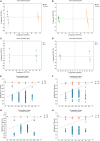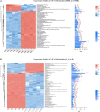Impact of Weissella cibaria BYL4.2 and its supernatants on Penicillium chrysogenum metabolism
- PMID: 36274712
- PMCID: PMC9581191
- DOI: 10.3389/fmicb.2022.983613
Impact of Weissella cibaria BYL4.2 and its supernatants on Penicillium chrysogenum metabolism
Abstract
Lactic acid bacteria (LAB) can produce a vast spectrum of antifungal metabolites to inhibit fungal growth. The purpose of this study was to elucidate the antifungal effect of isolated Weissella cibaria BYL4.2 on Penicillium chrysogenum, the antifungal activity of W. cibaria BYL4.2 against P. chrysogenum was evaluated by the superposition method, results showed that it had obviously antifungal activity against P. chrysogenum. Studying the probiotic properties of BYL4.2 and determining it as beneficial bacteria. Furtherly, different treatments were carried out to characterize the antifungal activity of cell-free supernatant (CFS) produced by W. cibaria BYL4.2, and it was shown that the CFS was pH-dependent, partly heat-sensitive, and was not influenced by proteinaceous treatment. The CFS of W. cibaria BYL4.2 was analyzed by high-performance liquid chromatography (HPLC) and found the highest content of lactic acid. Screening of metabolic markers by a non-targeted metabolomics approach based liquid chromatography-mass spectrometry (LC-MS). The results speculated that organic acid especially detected D-tartaric acid was the main antifungal substance of CFS, which could cause the down-regulation of metabolites in the ABC transporters pathway, thereby inhibiting the growth of P. chrysogenum. Therefore, this study may provide important information for the inhibitory mechanism of W. cibaria BYL4.2 on P. chrysogenum, and provide a basis for further research on the antifungal effect of Weissella.
Keywords: LAB; Penicillium chrysogenum; Weissella cibaria; antifungal effect; metabolome.
Copyright © 2022 Yao, Wang, Ma, Wu, Xu, Yu, Zhang and Zheng.
Conflict of interest statement
The authors declare that the research was conducted in the absence of any commercial or financial relationships that could be construed as a potential conflict of interest.
Figures








References
-
- Buddhala C., Prentice H., Wu J.-Y. (2012). Modes of Action of Taurine and Granulocyte Colony-stimulating Factor in Neuroprotection. J. Exp. Clin. Med. 4 1–7. 10.1016/j.jecm.2011.11.001 - DOI
-
- Chen H., Ju H., Wang Y., Du G., Yan X., Cui Y., et al. (2021). Antifungal activity and mode of action of lactic acid bacteria isolated from kefir against Penicillium expansum. Food Control 130:108274. 10.1016/j.foodcont.2021.108274 - DOI
LinkOut - more resources
Full Text Sources
Other Literature Sources
Miscellaneous

